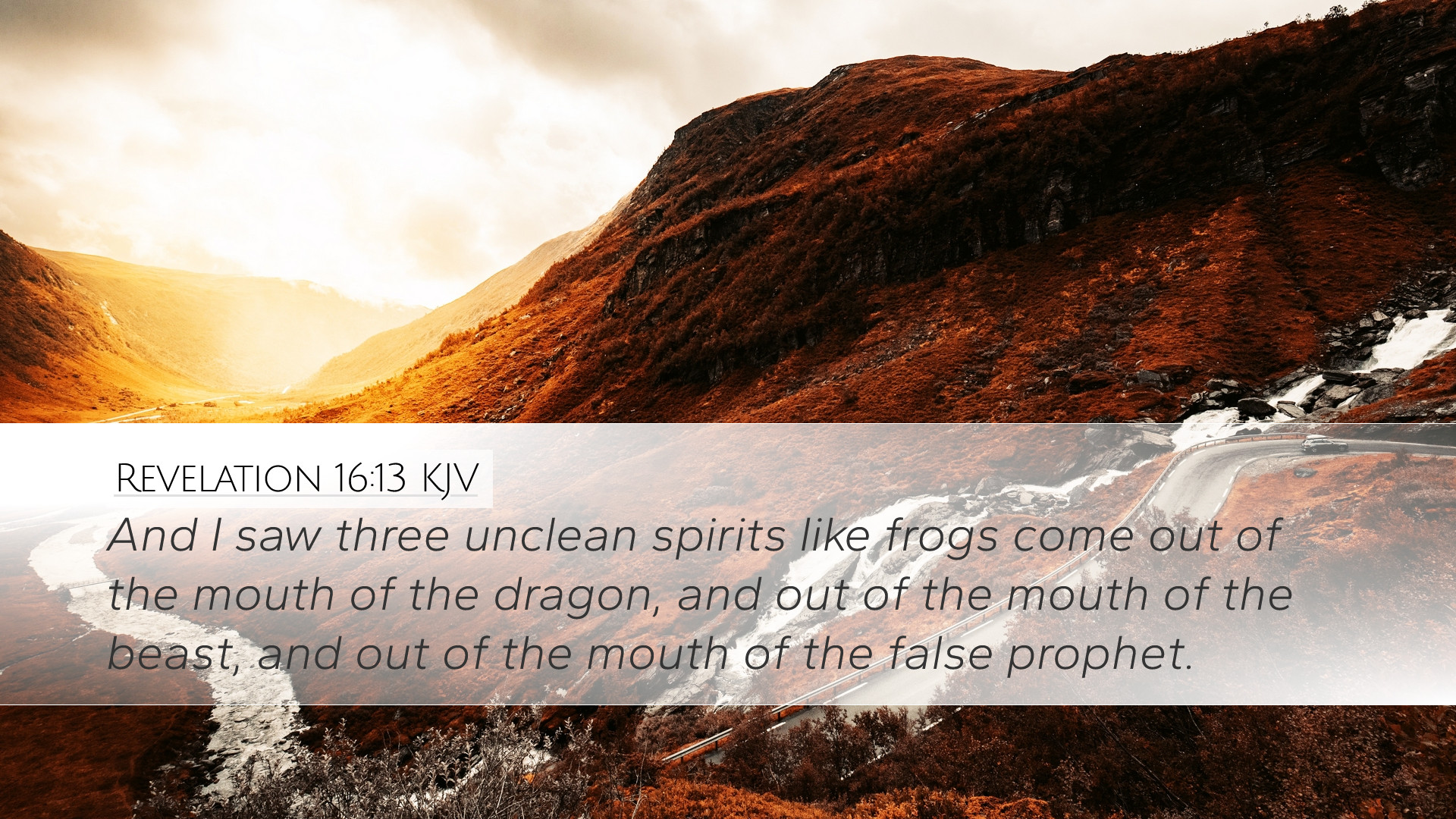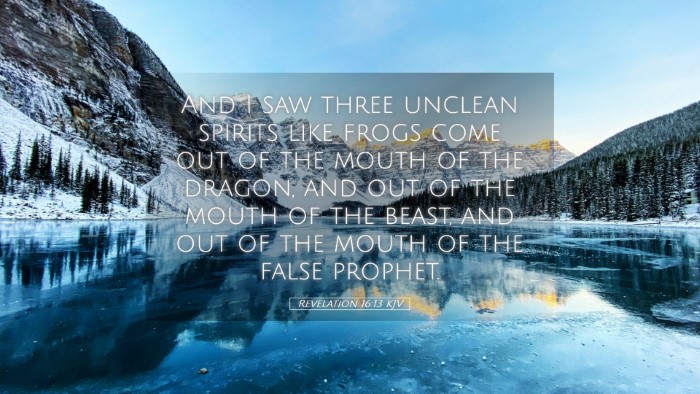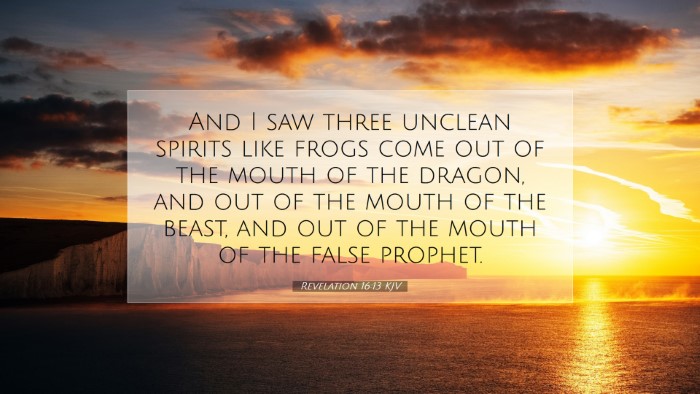Commentary on Revelation 16:13
Verse: "And I saw three unclean spirits like frogs come out of the mouth of the dragon, and out of the mouth of the beast, and out of the mouth of the false prophet."
Introduction
The passage in Revelation 16:13 serves as a pivotal moment in the apocalyptic narrative. In this verse, the imagery of the "three unclean spirits" symbolically reflects the unholy trinity of evil: the dragon, the beast, and the false prophet. Commentators like Matthew Henry, Albert Barnes, and Adam Clarke provide various insights that highlight the theological implications and the symbolic interpretations relevant to understanding this verse in the broader context of Revelation.
The Imagery of Unclean Spirits
The depiction of spirits as "frogs" is notable. Frogs, considered unclean animals under Jewish law (Leviticus 11:10-11), suggest a purveyance of impurity and spiritual defilement. Matthew Henry explains that the frogs represent the insidious nature of these spirits, which are meant to entice and lead astray God's people.
Symbolism of Frogs
Albert Barnes notes that frogs are typically associated with noisiness and activity. This resonates with the idea that these unclean spirits are not idle; they actively engage in their deceiving work. They emerge from the mouths of powerful entities, indicating that the deceptive power of these spirits emanates from their verbal declarations. Adam Clarke posits that the spontaneous and pervasive nature of frogs also mirrors how these spirits will spread their influence across nations.
The Sources of the Unclean Spirits
This verse identifies three sources from which the unclean spirits emerge: the dragon, the beast, and the false prophet. Each figure possesses its own significant role within the narrative of Revelation.
- The Dragon: Represents Satan himself, symbolizing the ultimate source of evil and rebellion against God.
- The Beast: Usually interpreted as a representation of political power or a specific kingdom that opposes God and His people.
- The False Prophet: Symbolizes false religious systems or leaders that distort truth and lead humanity away from God.
Collective Deception
Commentators emphasize that the collective emergence of these spirits illustrates a coordinated effort of evil forces to deceive and gather the nations against God. Barnes notes that together, they represent a comprehensive approach to bear falsity and influence over the earth's inhabitants. Henry elaborates that just as these spirits mimic divine action, they seek to unite the world in rebellion against God’s kingdom.
Theological Significance
This verse is rich with theological implications. The description of unclean spirits coming out of the mouths of these three figures suggests the potency of spoken words. Clarke states that whatever comes out of the mouth has the potential to either impart life or produce death—a theme prevalent in biblical literature (Proverbs 18:21).
The Nature of Evil Speech
The unclean spirits speak with the authority of their respective origins. The image of coming "out of the mouth" signifies their deceptive proclamations and lies. This notion translates effectively into pastoral contexts; today’s believers must discern the voices they hear, as many are still susceptible to false teachings and deceitful spirits echoed through modern mediums.
The Purpose of the Spirits
These spirits are not just forgeries of signs and wonders; they carry out a specific mission. Revelation 16:14 continues this theme, indicating their role in gathering the kings of the earth for the battle of Armageddon. Henry remarks that the end goal of these unclean spirits is to unite the world's leaders for the ultimate confrontation against God.
The Final Confrontation
This climactic scene demonstrates God’s sovereignty in allowing evil to reach its zenith before divine intervention. Clarke posits that such a confrontation serves as both a warning and a reminder—God will ultimately judge the wickedness that these spirits facilitate.
Pastoral Application
For pastors and spiritual leaders, Revelation 16:13 prompts a rigorous examination of influences within the church and society. The presence of "unclean spirits" challenges the faithful to uphold discernment and vigilance. Authentic teachings grounded in scripture serve as the antidote to the alluring but dangerous teachings of the "false prophet."
Encouragement for Believers
The assurance lies in recognizing that while evil may seem to prevail temporarily, God's victory is certain. Clarke's insights remind believers to cling to hope while contending against the various manifestations of evil they observe in the world. The reality of spiritual warfare echoes through these verses, calling Christians to engage in prayer, discernment, and scriptural fidelity.
Conclusion
Revelation 16:13 serves as a sobering reminder of the ongoing battle between light and darkness. Matthew Henry, Albert Barnes, and Adam Clarke collectively guide readers toward a nuanced understanding of this passage, providing a rich tapestry of insights ranging from the nature of evil spirits to practical applications for modern believers. As pastors, students, theologians, and scholars delve into this verse, may they be inspired to proclaim the truth and safety found in our Lord amidst an age where deceptive voices abound.


